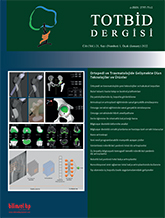
Artificial intelligence applications have become a part of our daily life. Deep learning methods like convolutional neural networks are promising in the evaluation of processing medical data, with their image recognition and evaluation capabilities. At the same time, it has the potential to evaluate databases that exceed the analysis capacity of human power. The aim of this article is to explain the working logic of convolutional neural networks and also to examine the examples of their application in total hip arthroplasty. Although the idea of convolutional neural networks was introduced in 1959, it has made a great breakthrough in the last 10 years as a result of developments in computer science. Its use in the field of medical imaging has become widespread with its image recognition power, classification of images without human intervention, and evaluation of large data sets. The goals of use in the field of medical imaging are, reducing the amount of radiological workups, reducing the bias caused by the human factor, reaching more accurate diagnoses, and developing cost-effective systems. Successful applications have been developed in the field of total hip arthroplasty. In preoperative planning, determination of acetabular and femoral component placement, evaluation of the alignment, determination of component sizes, detecting the brand and model of the existing implants for revision surgeries, intraoperatively with the evaluation of the hammer sounds during the placement of the femoral component, predicting the risk of periprosthetic fracture, post-operatively, implant placements, detection of aseptic loosening from plain radiographs can be given as examples of the studies with convolutional neural networks in total hip arthroplasty. Algorithms developed with convolutional neural networks offer solutions that will affect our daily practice. However, in order not to cause ethical problems, more explainable models should be developed and for the development of more accurate algorithms, larger datasets should be obtained.